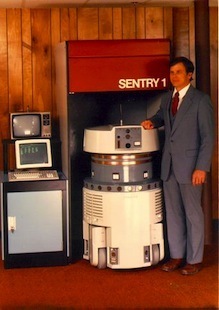Roboscrews
 One of my current projects is a think piece about robots, specifically those that may soon be charged with carrying out morally weighty duties. That line of inquiry has led me to delve into the history of robot prison guards—or, perhaps more accurately, robots that were briefly purported to be the prison guards of the future. Such plans have obviously never come to fruition, but the Denning Sentry apparently came close to making the penitentiary rounds back in 1985, when this admiring piece appeared in Popular Science:
One of my current projects is a think piece about robots, specifically those that may soon be charged with carrying out morally weighty duties. That line of inquiry has led me to delve into the history of robot prison guards—or, perhaps more accurately, robots that were briefly purported to be the prison guards of the future. Such plans have obviously never come to fruition, but the Denning Sentry apparently came close to making the penitentiary rounds back in 1985, when this admiring piece appeared in Popular Science:
Southern Steel Co. of San Antonio, Texas, the country's largest maker of prison bars, beds, and other detention-facility hardware, has ordered 600 copies of Denny; eight of these, destined for prison duty, are now undergoing advanced testing. Denning is also building robot sentries with slightly different capabilities for another private security firm, and still others to patrol factories.
A Denning Sentry can detect, within a 150-foot radius, the presence of anything or anybody that shouldn't be there, the company claims. Its swiveling head contains microwave and infrared (IR) sensors that can detect people as well as smoke. In future editions the head will also contain sniffers that can smell the faint ammonia aroma of a human body.
Needless to say, the Denning Sentry never fulfilled its promise: its maker, Denning Mobile Robotics, went bankrupt in 1993, though it experienced a brief revival shortly thereafter thanks to Australian robotics guru Allan Branch. The problem does not seem to have been handwringing over the moral issues raised by putting robots in charge of human, but rather because the Sentries cost way too much—about $110,000 in Reagan-era money, not including maintenance. An entry-level human guard, by contrast, runs just $22,010 in today's dollars.
There doesn't seem to have been much consideration given to the potential for robot prison guards since the Denning Sentry's flameout. But I have to think it's a natural next application for the technology once SUGVs evolve a bit more. Let's hope folks stop to ponder the moral dimension to that usage—I have to wonder if human guards will be more willing to employ violent measures if they're operating a robot from a remote location, rather than actually walking the prison floors.
(Image via SPAWAR)




